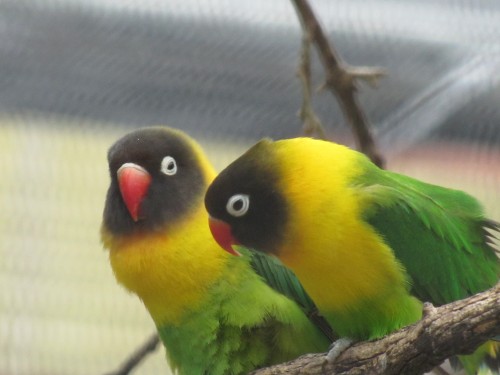Yellow-collared Lovebird, Adelaide Zoo
I must admit that I am not a fan of Lovebirds. I have heard that they can be very aggressive as a cage bird. I am also wary that some will escape from captivity and establish feral populations here in Australia. This has happened with other species over the years and it would mean that they would compete with native species for food and nesting sites.
Despite these feelings, I must admit that the birds shown in my photos today are attractive, so I can understand why some people would want to keep them as pets. These photos were taken through the wire of an aviary in the Adelaide Zoo here in South Australia.
Yellow-collared Lovebirds are native to Tanzania in southern Africa.
Cockatiel parrots
The public aviary I visited in Pinnaroo last week contained a good variety of Australian parrots. One species I was able to photograph through the wire mesh was a Cockatiel parrot. Up until now I hadn’t managed a good shot of this species in the wild, so I was pleased to get this photo.
Cockatiels are found throughout many parts of mainland Australia, except coastal NSW and southern Victoria. Their preferred habitats include open woodlands, scrubland, plains, timbered watercourses and grain growing farmlands. They are known to be nomadic in response to rainfall.
They make their nest in a tree hollow, often near water and their breeding season is from August to December.They feed on a variety of grass seeds, nuts, berries and grain.
They are known in some areas by their Aboriginal name Quarrion, a name which mimics one of their calls. They make excellent pets and can be taught to speak a few words. I remember having one at home when I was a child, but he didn’t learn many words – despite my efforts.
Related articles:
Bird aviary, Pinnaroo Caravan Park
During my visit to Pinnaroo last week I saw a sign pointing to a public aviary. It turned out to be adjacent the caravan park and consisted of one large aviary (shown in the photo above) plus three or four smaller ones. Surrounding these aviaries was a large enclosure with some Emus and a Black Swan in residence. The larger aviary contained a variety of Australian parrots and a Peaceful Dove.
A sign on the front of the cage says: “Be careful: we may bite.” (Click the image to enlarge.)
The one I’d be most careful of was the Sulphur-crested Cockatoo. He immediately came to the wire in front of me to check me out and to inspect my camera – or was it to pose for a photo? I certainly wouldn’t like to get my finger in his beak!
I had trouble taking photos through the wire mesh, and wherever I tried to focus on the birds through it, the cockatoo came and posed front and centre. I guess he figured that he was the star of the show. Of course he had been taught to speak the usual phrases and greeted me with a cheery “Hello Cocky” as I was getting out of the car. He then proceeded to use his full vocabulary like “Dance, Cocky, dance” and other phrases.
Related articles:






